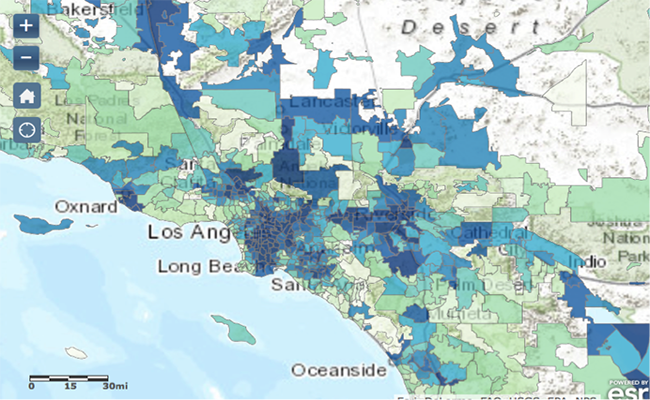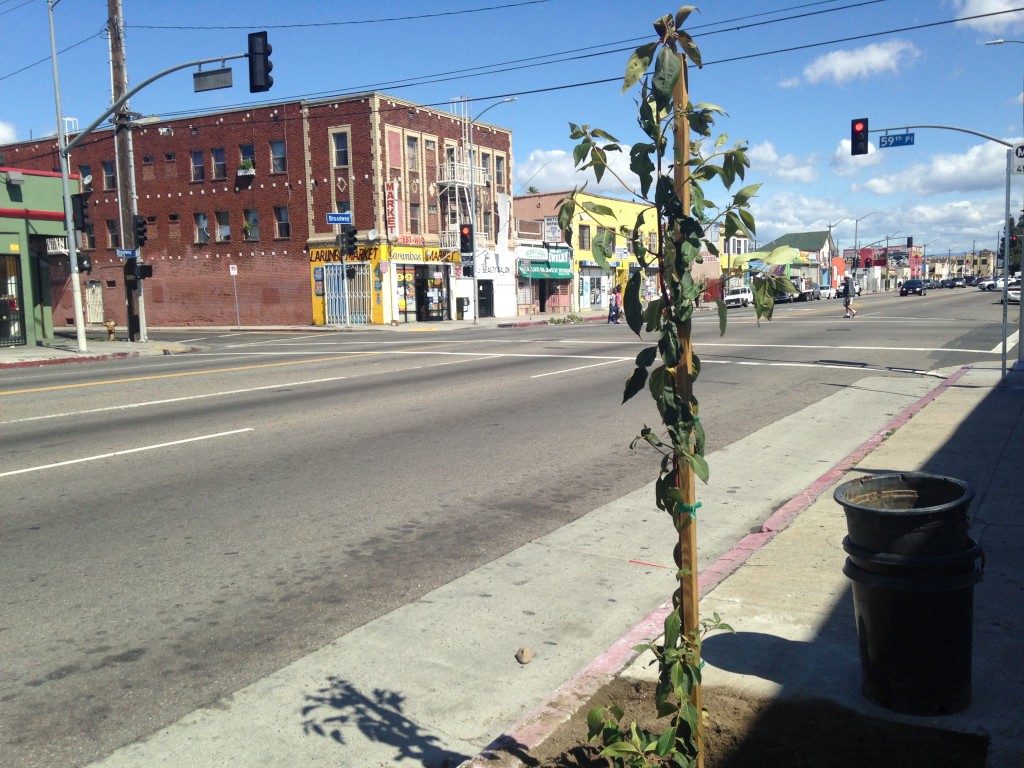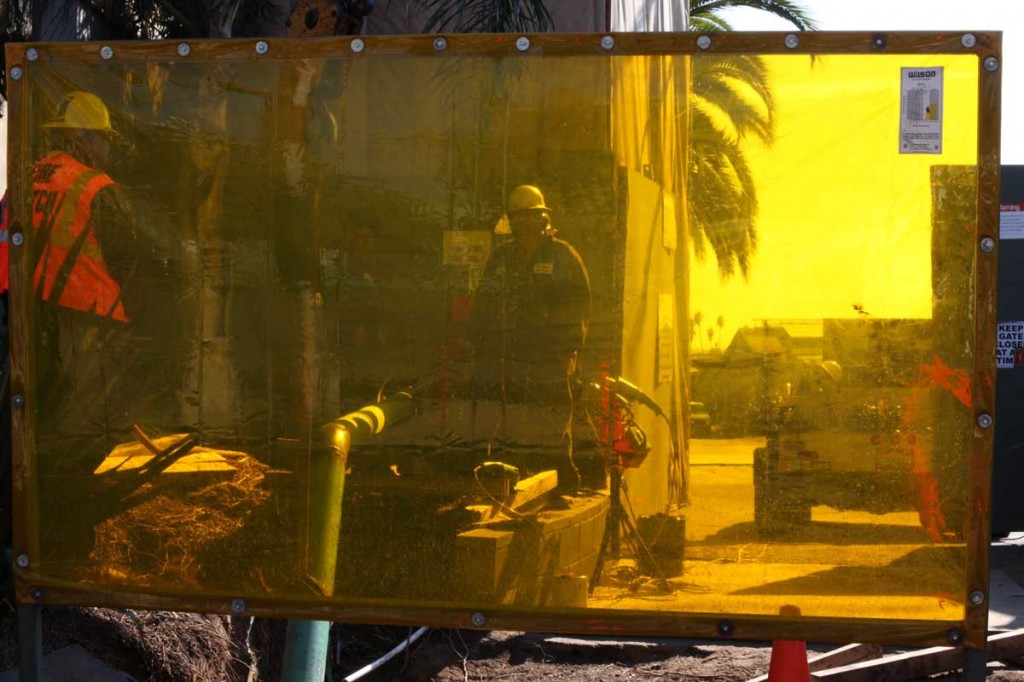
Screenshot of the Southern California area on CalEnviroScreen. The dark blue portions indicate the most polluted areas. | CalEnviroScreen
Many California residents, particularly in metropolitan areas like Los Angeles, gripe about the smog that chokes the horizon. But some communities, including several in South Los Angeles, have it worse than others.
According to a recent report from the Office of Environmental Health Hazard Assessment, ethnic minorities comprise a large proportion of residents in California’s most polluted neighborhoods despite making up a relatively small percentage of the statewide population.
An online tool called the CalEnviroScreen depicts California’s pollution levels by the state’s more than 8,000 census tracts using a color scale. It shows immediate pollution levels as well as “potential vulnerability.” Launched in 2012, the tool has been updated several times since. Recent versions include an analysis of the relationship between race and the CalEnviroScreen scores. The data indicates that Latinos and African Americans are disproportionately affected.
Clumps of dark blue represent the most polluted areas in California. South L.A. neighborhoods like Compton, Lynwood and Vernon have some of the highest pollution rates, which linger mostly in the 90th percentile.
Compton, for example, is home to some of the highest rates of hazardous waste, impaired water bodies, traffic, and pesticides in California. Meanwhile, 67 percent of Compton’s population is “linguistically isolated,” meaning the residents speak little or no English.
The report finds that African Americans, who make up fewer than 13 percent of the statewide population, live in almost a third of the worst polluted census tract areas.
Latinos represent a majority of the top ten percent of most of the polluted areas, although only 37.6 percent of California residents are Latino.

The organization City Plants spearheaded the installation of 120 trees on Broadway in South L.A. in April, partially to combat urban pollution. | Daina Beth Solomon
Low-income neighborhoods feel the burden
Ed Avol, an expert on air pollution and public health, said the lower-rent areas often occupied by ethnic minority groups tend to be located near busy freeways or industrial facilities. People who live in these neighborhoods can get overlooked when it comes to political decisions that could impact pollution, he said.
“Without a political ally to represent their community’s point of view, people tend to get ignored in key developmental decisions such as where a new freeway or rail yard may be built,” Avol said. “These facilities are rarely built in highly affluent places like Beverley Hills or Palos Verdes.”
Certain community groups are working hard to get the attention of their legislatures to help eliminate pollution in underserved neighborhoods. At Communities for a Better Environment in Huntington Park, in Southeast L.A., organizer Roberto Cabrales hopes to motivate residents to hold officials and polluters responsible for cleaning up their neighborhoods.
“We’re surrounded by manufacturing hubs — stationary sources [of pollution] that produce and handle chemicals,” said Cabrales, naming body shops and power plants as examples.
Toxic Strike Team steps in
Facilities dealing in toxic chemicals have long operated in minority and low-income neighborhoods across the country, an issue that prompted President Bill Clinton to write an executive order calling for “environmental justice.” That was 20 years ago.
“Environmental racism” is still a problem today, attorney Patty Bilgin from the City Attorney’s Environmental Justice unit told the L.A. County Board of Supervisors at a meeting in March.
“The quality of air you breathe and water you drink should not be dictated by the color of your skin,” she said.
Heeding that admonition, supervisors voted in March to create a “Toxic Threat Strike Team” to crack down on sites releasing toxic chemicals, picking up the slack from state agencies charged with enforcing pollution standards.
“We’ve gone to different agencies and asked that they close them down, and all they do is give them another opportunity to clean them up and make excuses,” said Molina, who proposed the taskforce. “It’s enough.”
The team will pay special attention to sites in what supervisor Gloria Molina calls “highly burdened communities” – areas already beset with issues such as crime and poverty, such as South L.A. and East L.A.

A look into the Murphy oil drilling site in the residential West Adams neighborhood of South L.A. | Stephanie Monte
Possible crackdown for South L.A.
Molina has her eye on several facilities that she says need tighter supervision (or to be shut down altogether), like oil drilling sites in South L.A.
Residents say the oil drilling at three sites in low-income, residential neighborhoods near the University of Southern California has caused symptoms like nosebleeds and headaches. And activists say they fear entire neighborhoods are at risk from chemicals that oil companies refuse to identify.
The Environmental Protection Agency has just ordered AllenCo Energy Inc., which operates a drill site on a pedestrian-frequented street surrounded by six schools, to pay $700,000 in upgrades to prevent “accidental releases” of hazardous substances. The move comes after a community campaign called “People Not Pozos” (“People Not Oil Wells”) and hundreds of neighbor complaints.
Nearby in West Adams, locals have also rallied to halt drilling at two wells operating in densely populated neighborhoods of homes and schools, citing potential dangerous affects on the environment.

Doelorez Mejia wears a cape reading “Exide Kills” at a Board of Supervisors Meeting in March. | Daina Beth Solomon
Exide targeted for East L.A. pollution
Before it undertakes remediation measures in South L.A., the Toxic Strike Team plans to do a trial run in Vernon, where Exide runs a battery recycling plant.
The company bought the site in 2000, and officials have said the facility recycles 8 million car batteries each year. It is one of only two such plants west of the Rocky Mountains.
The Department of Toxic Substance Control recently discovered lead in the soil at nearly 40 homes and two schools in East L.A. near the plant, which occupies a 15-acre plot between the L.A. River and the 710 Freeway in Vernon. Lead exposure is less hazardous to adults, but it can cause medical disorders in young children, who absorb it at four to five times the rate of adults, according to the World Health Organization.
The neighborhood may also contend with arsenic exposure. The South Coast Air Quality Management District reported a year ago that Exide was emitting enough arsenic to affect the health of more than 100,000 residents.
Plant manager John Hogarth said Exide is spending $20 million on environmental upgrades, mostly to reduce emissions and improve the company’s “environmental footprint.”
East L.A. resident Doelorez Mejia cautioned that the new oversight is just a first step.
“I like the idea of a task force, but who do you bring it to? Who’s going to regulate it?” said Mejia, who came to the March Supervisors’ meeting in a hospital gown and surgical mask, waving a glossy poster of a gas mask in front of her face. Mejia also fashioned a cape out of a skull and crossbones flag, upon which she had written in black marker: “Exide Kills.”
The Mothers of East Los Angeles, an activist organization, has been urging officials to shut down Exide for seven years, said Maria Teresa Griffin, a member who has worked to inform her neighbors about the plant for at least that long.
She said East L.A. locals don’t always speak out loud enough against community abuses, but in this case, “we’re really trying.”
“If it were somewhere else, people around the area wouldn’t tolerate this,” said Griffin.
Correction: CalEnviroScreen depicts California’s pollution levels by census tract. An earlier version of this article incorrectly stated that its data is based on ZIP code areas.
Like Intersections on Facebook, follow us on Twitter and sign up for the Newsletter to stay in the loop on news and views from South L.A.















Speak Your Mind